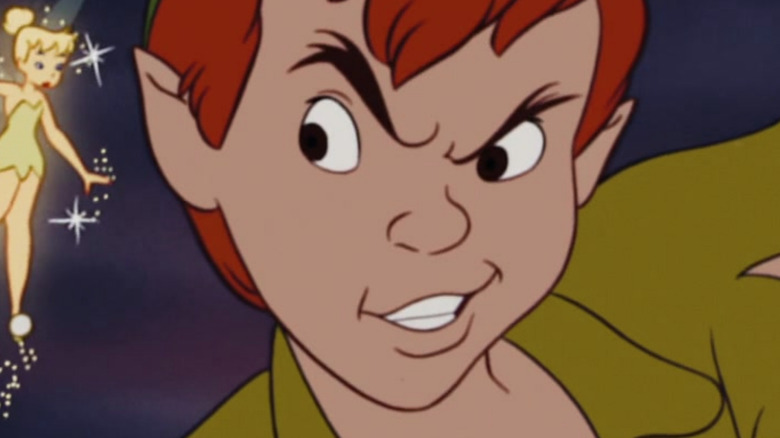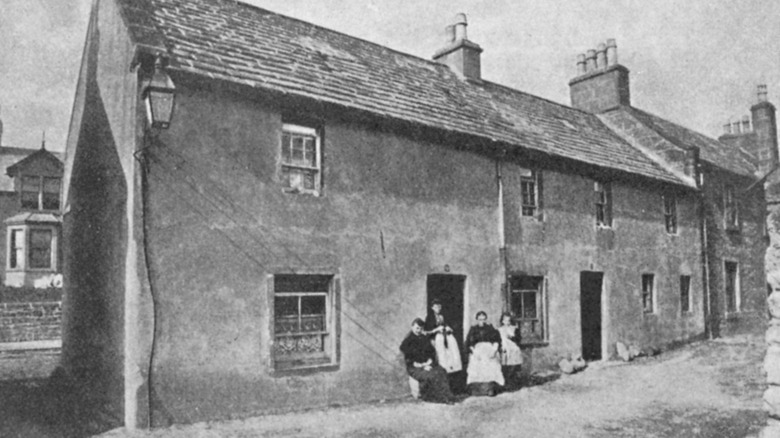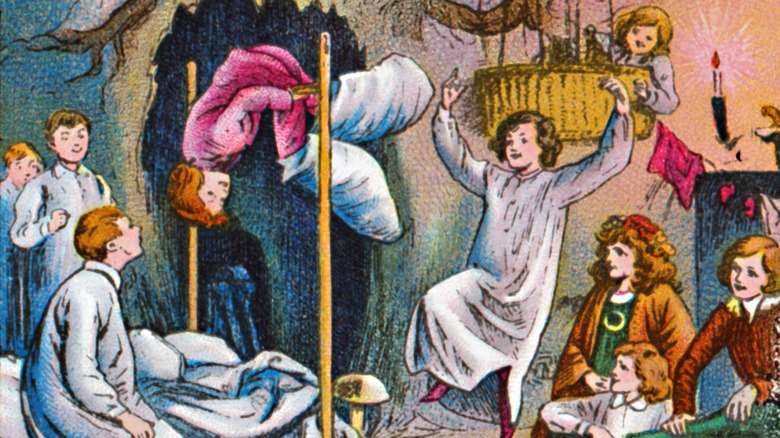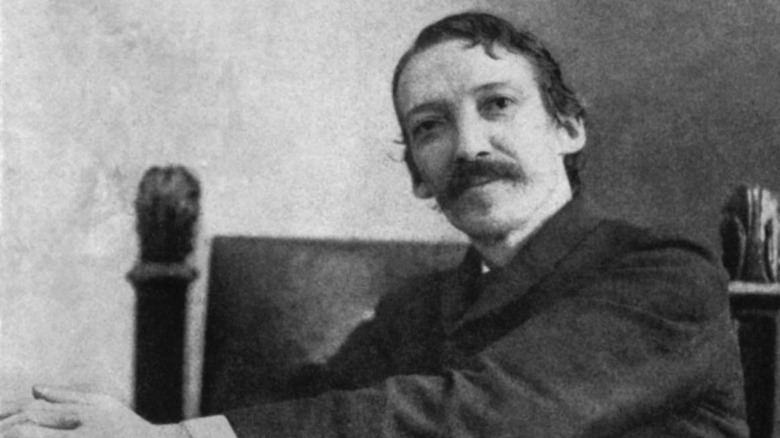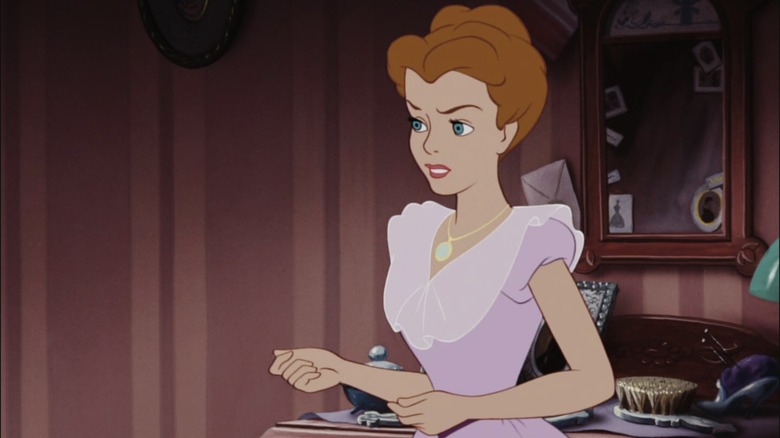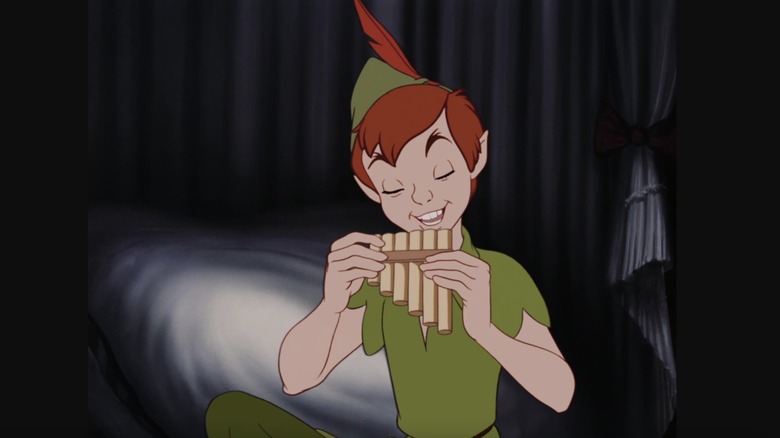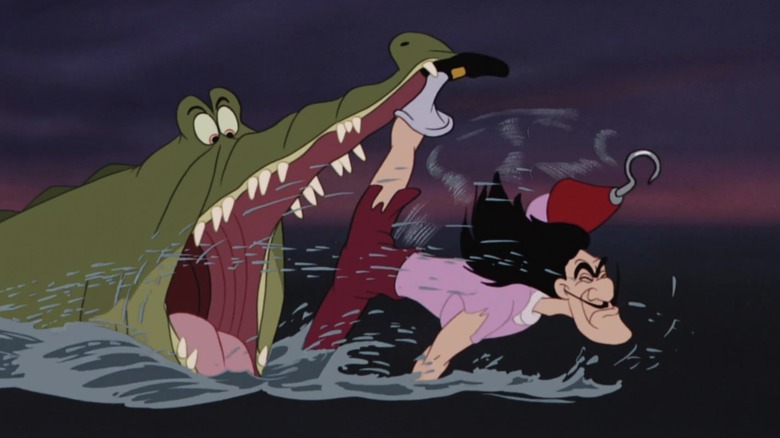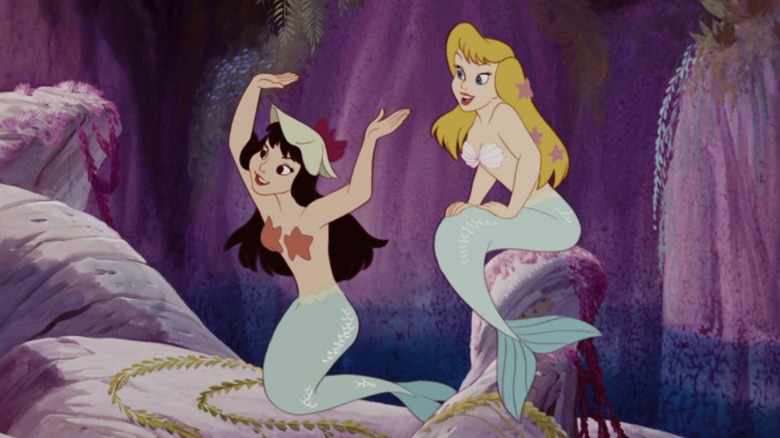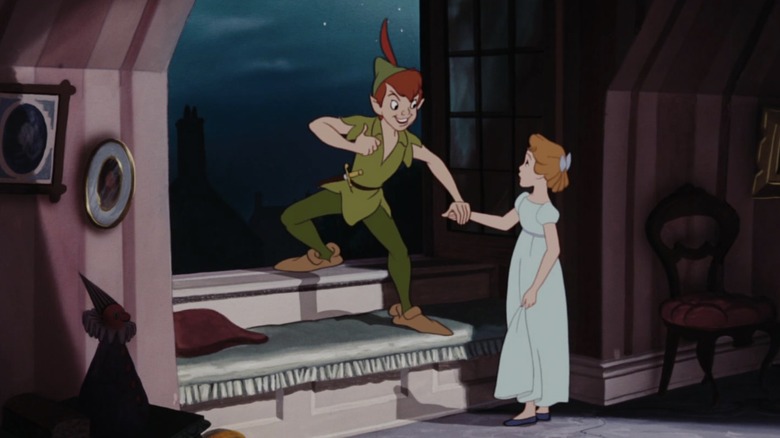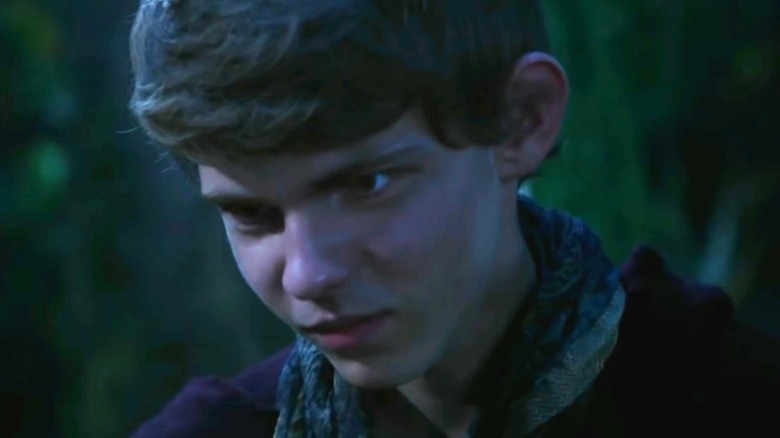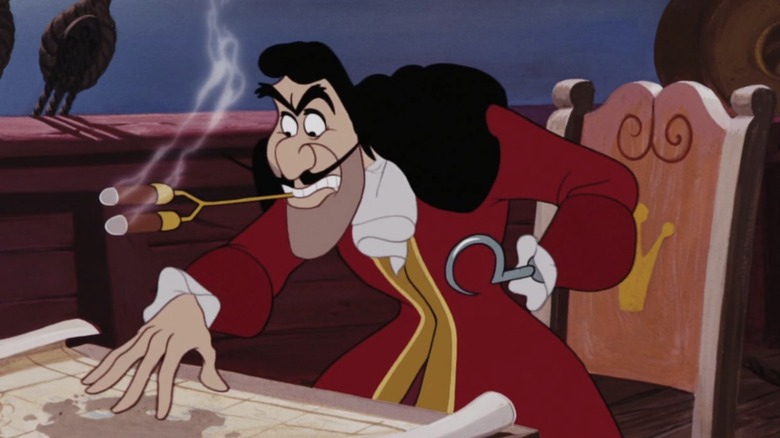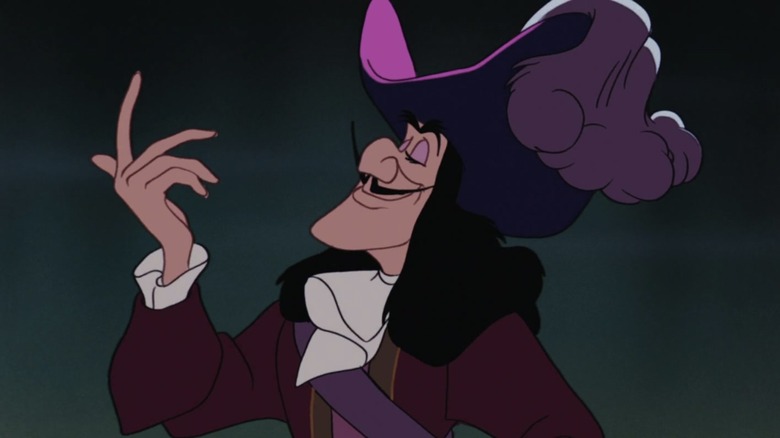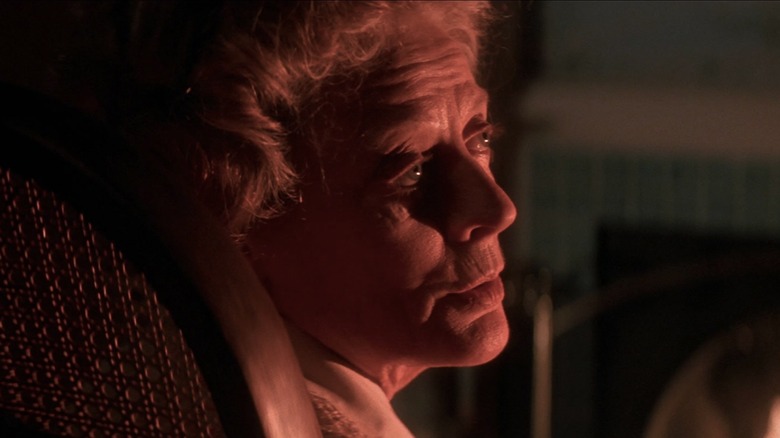The Dark History Of Peter Pan
"Peter Pan" has become a beloved children's fairy tale, but many of us are only familiar with the Disney version of the story. Like many fairy tales, folktales, and myths, Peter Pan has a dark side. And there is something almost archetypal about the character, leading some writers to believe J. M. Barrie created a modern myth when he dreamt up Peter Pan, the boy who never grew up (per The New Yorker). Barrie tapped into the inherent magic of children's imaginations and a deep longing some adults have to return to the simplicity of childhood, hoping to escape the troubles of adulthood.
As Noelle Conder explores in her scholarly essay "Peter, Pan, and Persephone: Keepers of the Mythical Wild," Barrie's Peter Pan is a mythic figure. Like all ancient myths, he began in the oral tradition as a story Barrie first told the Llewelyn Davies children. But like other myths, Peter Pan was retold, growing into a few chapters in a book and later a play, then a novel, all written by Barrie himself. Like many myths, Peter Pan captured the popular imagination and has been retold in many iterations as plays, films, and literary works inspired by Peter Pan, his Lost Boys, and Neverland.
The original 1904 play, "Peter Pan; or, the Boy Who Wouldn't Grow Up," and the 1911 novel that followed, "Peter and Wendy," are different from the sanitized Disney version so many of us are familiar with. Join us as we explore the dark history of Peter Pan.
J. M. Barrie's tragic childhood
James M. Barrie had a tough childhood. When James was only 6 years old, his older brother David, who was regarded as a perfect child in the Barrie household, was injured during an ice skating accident, hitting his head after another skater collided with him. David fractured his skull and died the day before his 14th birthday from his injuries (per The New Yorker).
The death of James' older brother, David, scarred James. Biographer Piers Dudgeon made the controversial suggestion in his book "Captivated" that young James may have been the skater who collided with David (per The Herald). Dudgeon said, "It is speculative. But it does add to the emotional picture of Barrie. A terrible guilt, associated with an accident in which your brother died, is something you would carry with you for the rest of your life."
After David's death, their mother, Margaret Ogilvy, drifted into a deep depression. Margaret laid in the darkness of her room, while her eldest daughter, Mary Ann, who was 20 when David died, cared for her younger siblings. Margaret herself had lost her mother when she was only 8 years old and began taking care of her siblings. Feeling like she'd been cheated out of her childhood, Margaret took solace in her belief David would never grow up because he died at 13. These experiences influenced Barrie's life and his work as a writer (per "J. M. Barrie: His Search for a Mother Figure").
J. M. Barrie's strange friendship with the Llewelyn Davies children
J. M. Barrie enjoyed the company of children. In fact, Barrie donated the U.K. rights of "Peter Pan" to the Great Ormond Street Hospital for Children in 1929. In 1898, Barrie met George and Jack Llewelyn Davies in Kensington Gardens where the boys played with their nanny. He later became friends with the boy's parents, Arthur and Sylvia, and a fixture in the Llewelyn Davies household as Arthur and Sylvia welcomed three more boys, Peter, Michael, and Nico, into their growing family (per Vox).
Barrie became known as "Uncle Jim" to the boys, bringing his wife along for vacations with the Llewelyn Davies family, where Barrie entertained the boys with stories and make-believe games. The Llewelyn Davies boys were Barrie's inspiration for creating Peter Pan. In the preface to the 1911 children's book, Barrie dedicated the work to the Llewelyn Davies boys, saying, "I always knew that I made Peter by rubbing the five of you violently together, as savages with two sticks produce a flame.... That is all Peter [Pan] is, the spark I got from you" (per Andrew Birkin).
Barrie became the boys' legal guardian after their parents died of cancer (per The New Yorker). Barrie altered Sylvia's will to give himself guardianship of the boys (per The Telegraph). Contrary to speculation about the nature of Barrie's relationship with the boys, Barrie was not a pedophile. The youngest of the Llewelyn Davies boys, Nico, suggested Barrie was asexual, saying, "I don't believe that Uncle Jim ever experienced what one might call a stirring in the undergrowth for anyone — man, woman, adult or child. He was an innocent."
Peter Pan first appeared in Barrie's novel The Little White Bird
Peter Pan first appeared in "The Little White Bird," a 1902 novel written for adults by J. M. Barrie (per The Week). "The Little White Bird" is a little creepy and has ominous overtones. The novel is about an unnamed narrator who makes up a story about his son dying to ingratiate himself to Mary, the mother of a little boy named David whom the narrator has grown attached to, and wishes to, "take [David] utterly from her and make him mine" (per Refinery29).
This narrator makes up a story to draw young David to him. This imaginative tale is about a week-old baby, Peter Pan, who flies away with the birds to Kensington Gardens to play with the fairies and never ages (per Vox). As creepy as the seemingly predatory story of "The Little White Bird" is, people loved the Peter Pan chapters in the novel, inspiring Barrie to write the 1904 play "The Boy Who Wouldn't Grow Up" and the subsequent 1911 novel.
Barrie first named the play The Boy Who Hated Mothers
According to the biographer Andrew Birkin, the working title for the 1904 play was "The Boy Who Hated Mothers." Barrie even wanted the actress who played Mrs. Darling to also play the villain, Captain Hook. The original title reflected Barrie's complex relationship with his mother, his two failed marriages, and the fact that, although he raised the Llewellyn Davies' children as their guardian, Barrie had no biological children. Some speculate Barrie never consummated his marriages (per The New Yorker).
It seems J. M. Barrie based the character of Peter Pan on himself. Like Peter, Barrie resisted growing up, an idea he got from his mother who lamented how she became the lady of the house when she was just 8. As Elise Joyner suggests in her essay, "J. M. Barrie: His Search for a Mother Figure," his mother's deep depression led to Barrie's feelings of abandonment.
Barrie put these emotions into his art, creating Peter Pan, a week-old baby who runs away to play with the fairies and feels rejected when he returns to discover his window closed and his mother cuddling another baby. In "The Boy Who Wouldn't Grow Up," Peter Pan is a tween searching for a mother to bring back to Neverland, settling on Wendy and her descendants to care for him and his Lost Boys. Wendy isn't a proper mother. She is still a child, caring for other children, as his mother and sister once did.
Peter Pan is a representation of the Greek god Pan
Peter Pan, often seen with his pan pipes and his obvious links to nature, is a personification of the Greek god of the wild. Peter Pan's name and the symbol of the pipes are dead giveaways Greek mythology inspired Barrie when creating Peter. Pan is a friend to nymphs in Greek mythology. While nymphs are absent from Neverland, Peter is friends with the pixies, as Tinkerbell is one of his rowdy band. Peter is also the only creature the mermaids will associate with, further cementing Peter's associations with the god Pan.
Pan is a fertility god, known for his virility and often too amorous with the nymphs, who don't appreciate his attention. Peter is prepubescent and not concerned with such things, but his magnetism is clear. Wendy wants to kiss Peter and wishes he would play house with her. The mermaids are clearly smitten with Peter, and Tinkerbell is in love with him and driven to near-homicide by her jealousy of Wendy. Even Tiger Lily seems taken with Peter.
Pan is also known for his ability to incite panic, leading this god into the realm of trickster gods. Peter's moral ambiguity and rebelliousness center him squarely in the realm of trickster figures (per Eva Valentova's essay). Peter Pan certainly embodies the archetype of one who revels in chaos. He regularly incites it by starting fights with Captain Hook, encouraging wildness in the Lost Boys, and insisting the only rule in Neverland is that you can't grow up!
Peter Pan is obsessed with death
Although we think of Peter Pan as the boy who won't grow up, maybe he is the boy who avoids death by not growing up. As Dr. Lester D. Friedmanm, who co-wrote "Second Star to the Right: Peter Pan in the Popular Imagination," suggests, if we look at the story symbolically, Hook represents death, something Peter is always fighting against and the crocodile represents our time on Earth ticking away (per The Week). His co-author, Dr. Allison Kavey, has another theory. She believes Peter Pan doesn't age because he is already dead, saying, "There is the sense that Neverland is the place that sick children go in their minds. But some never get to come home."
This is a fascinating and dark take on the children's story. Taking this idea one step further, is it possible Peter Pan is Death? Noelle Conder suggests in her essay "Peter, Pan, and Persephone: Keepers of the Mythical Wild" that Peter Pan is the literary love child of the Greek god Pan and Persephone, the goddess of spring who became queen of the underworld. As their metaphorical child, Peter would be an important part of the life cycle. Could Peter be a psychopomp, leading the souls of children to a magical place where they will never grow old? After all, one of Peter's most famous lines from the book is, "To die would be an awfully big adventure." Being a shepherd of souls to death would even link Peter to another Greek god, who was also a psychopomp and a trickster figure — Hermes.
The mermaids from Peter and Wendy are dangerous creatures
The mermaids were not in the original play, "The Boy Who Wouldn't Grow Up," but were instead added to the Peter Pan mythos in Barrie's novel, "Peter and Wendy." In the Disney film, they are depicted as aggressive toward Wendy. In fact, Peter is the only creature they will speak to. What we don't see in the Disney version is that at night they are transformed: "The most haunting time at which to see them is at the turn of the moon, when they utter strange wailing cries."
The mermaids from Neverland turn into sirens when the night falls, luring sailors to their deaths, much like Peter Pan lures children to Neverland. Modern ideas about sirens and mermaids have become connected and confused. In Ancient Greek myths, sirens were half-woman, half-bird creatures luring sailors to their death with their enchanting singing. Mermaids, meanwhile, are the half-fish, half-woman mythical creatures of the ocean of "Aquamarine" and "The Lure" fame.
In the 9th and 10th centuries, mermaids and sirens started being mixed up, with the beautiful half-fish, half-woman creatures being represented as sirens, while the avian creatures were also represented as sirens in art from that period. These inconsistent representations continued for hundreds of years, but by the 14th century, sirens were exclusively represented as half-fish, half-woman, conflating the two mythical creatures. These woman-fish hybrids are now considered good if they are called a mermaid, or evil if they are called a siren. Barrie embraced both ideas, making his mermaids transform in the moonlight.
Does Peter Pan kidnap children?
Peter lures children like Wendy and her brothers to Neverland, much like Persephone was kidnapped and taken to the underworld by Hades. This connection brings us back to Peter Pan's connections to, and obsession with, death. Although Peter Pan is depicted as mischievous in Disney's sanitized version of the tale, in the original play and book, Peter is decidedly more sinister. His affinity with the mermaids who transform into sirens in the moonlight suggests Peter Pan himself might be prone to transformation as well.
In her essay, Noelle Conder says, "Peter displays a siren-like nature which displays possible connections to the original sirens of lore that were Persephone's companions in the underworld," suggesting Peter Pan's connection to the mermaids goes beyond a simple affinity and that he is linked to the natural world in Neverland — he might even be Neverland's nature god.
Conder elaborates, saying, "Peter may have a supernaturally powerful gift of persuasion. The most persuasive creatures in the realm of mythology are the sirens, and their later counterparts the mermaids." This connection between Peter and the siren-like mermaids also suggests that perhaps Peter's motives for luring the children to Neverland might be darker than we had imagined, considering the sinister transformation the mermaids experience themselves.
Peter Pan also has links to the creepy legend of the Pied Piper
The television series "Once Upon a Time" is rooted in the imaginative world of fairy tales. Season 3 of the series delves into the Peter Pan legend, building a unique backstory for Peter (Robbie Kay) as a villain, rather than a mischievous boy who doesn't want to grow up. This series also makes the implicit link between the story of the Pied Piper and Peter Pan explicit, revealing that Pan posed as the Pied Piper to steal the children in a revenge plot. Like the Greek god Pan and the Pied Piper, Peter Pan always carries his pan pipes with him. Considering how Peter essentially kidnaps children by luring them to Neverland, he has obvious associations with the kidnapper the Pied Piper.
Most of us know the story of the Pied Piper from the Grimm fairytales or the poem by Robert Browning. The village of Hamelin hired the Pied Piper to take care of their rat problem, and he used a magic flute to lure the rats away to drown. Then when the village refused to pay him for his services, the Pied Piper absconded with their children in the same way. This medieval folktale might be based on historical fact (per the BBC). In the German town of Hamelin, a plaque reads, "A.D. 1284 — on the 26th of June — the day of St John and St Paul — 130 children — born in Hamelin — were led out of the town by a piper wearing multicoloured clothes. After passing the Calvary near the Koppenberg they disappeared forever."
The first draft of the play didn't have Captain Hook
Biographer Andrew Birkin found J. M. Barrie's original notes for Peter Pan at Yale in the Beinecke Library. In these notes, Birkin discovered the first draft of the play didn't have Captain Hook as a character. Barrie didn't need an antagonist, because Peter Pan was the villain. In his notes, Barrie called Pan a "demon boy," labeling him the true villain of the story as it was initially conceived. Birkin reveals Barrie created Captain Hook out of the need for what is known as a "front-cloth scene" to change the scenery from Neverland to the London nursery — Peter fighting pirates was a fun scene that could transpire while the stagehands shifted the set behind the curtain.
Those of us only familiar with the Disney version of the story might balk at Peter Pan being the villain in Neverland, but the 1904 play and the book "Peter and Wendy" certainly paint Peter in darker colors than the bright animation of Disney, as when Barrie writes, "The boys on the island vary, of course, in numbers, according as they get killed and so on; and when they seem to be growing up, which is against the rules, Peter thins them out; but at this time there were six of them, counting the twins as two." Let us make this plain: Peter Pan kills the Lost Boys when they are getting a little too long in the tooth! Killing your followers and friends is very villainous!
Hook attended the upper-crust school Eton
In J. M. Barrie's detailed backstory for Captain Hook, Hook attended Eton, the school Barrie sent four of the five Llewellyn Davies boys to be educated (per The Atlantic). No one knows when Barrie came up with Hook's backstory. Barrie continued tweaking the play until it was published 20-something years after its debut on stage, so Barrie may have come up with Hook's backstory years after he conceived of the captain himself.
Captain Hook's last words before being eaten by the crocodile in the play were "Floreat Etona," which is the school motto, meaning "May Eton flourish." Hook's obsession with "good form" certainly makes more sense once you learn he went to such a staunchly blue-blood institution. (He also apparently attended Balliol, a college of Oxford.)
In 1927, Barrie gave a lecture at Eton, revealing Hook's attachment to his alma mater and little tidbits not included in the book or play. For example, Barrie said Hook's chamber on the Jolly Roger was filled with the Eton Chronicle and that Hook left everything to Eton in his will. Poor Hook, as a pirate, knew his reputation might sully Eton, but he still loved the place. According to Barrie, the school's governor refused to accept the plunder of a pirate.
The book Peter and Wendy ends differently than the animated Disney film
The Disney animated version ends with Peter returning the children to London, where their parents find them sleeping after returning home. After returning the children, Peter and his Lost Boys sail away to Neverland upon the Jolly Roger, and Mr. Darling sees the pirate ship in the clouds, just before Wendy wakes up and tells her parents she is ready to grow up after all.
In the 1911 book "Peter and Wendy," the Darling children return home to London with the Lost Boys, and the Darlings adopt them. Peter refuses adoption, agreeing to Mrs. Darling's compromise, allowing Wendy to return to Neverland for a week each year to help with the spring cleaning. Peter comes for her a year later but forgets her the next year. The next time Peter comes for Wendy, she is a married woman with a child of her own. He is upset Wendy grew up until he realizes he can take Wendy's daughter Jane to Neverland, and when Jane is grown, her daughter Margaret will join him in Neverland too.
This ending was explored in "Hook," starring Robin Williams. The film follows what happen if Peter stayed in London, growing up with Wendy's granddaughter. The magic of J. M. Barrie's modern myth is how it has captured the popular imagination and continues to be an inspiration for countless series, films, and books. Some of these newer interpretations of this classic tale are even delving into Peter Pan's dark origins and exploring the possibility that he may have been the villain the whole time.
